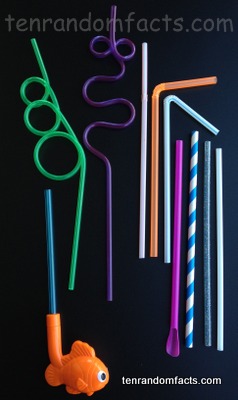Slurping loudly with a drinking straw is half the fun.
- A drinking straw is a thin, hollow tube used primarily to move a liquid from a container into one’s mouth using suction principles, and they are typically disposable, although reusable straws are available.
- Drinking straws work by sucking in air using the mouth, and as a result lower the air pressure, which in turn pulls the liquid through the tube.
- The shape of drinking straws range widely in diameter and length, although they are typically cylindrical, however some straws have crazy, twisted shapes primarily to entertain, or they may have an adjustable, bendy top, while others contain flavouring ingredients, and yet others include a spoon shaped end to generally scoop crushed ice into one’s mouth.
- The earliest known drinking straw, dating back to 2000 to 3000 BC, was found in a tomb belonging to Sumerians, located in modern day Iraq in the Middle East, and was made of gold and precious stone, while a seal found in the same tomb depicts straws used to drink a beverage, most likely beer.
- The 1800s saw the escalating use of drinking straws, in the form of rye grass, that notoriously disintegrated and left a rye residue and therefore a grassy taste in the beverage.
- Modern drinking straws were invented by Marvin Chester Stone from Ohio in the United States, who is said to have created a glued paper tube in the 1880s after drinking a beverage unpleasantly tainted with rye residue, and eventually patented his idea in 1888 after refining it.
- Drinking straws with an adjustable upper bend, known as ‘bendy straws’, ‘articulated straws’, or ‘flexi straws’, made their appearance in the 1930s, created and patented in 1937 by American Joseph Friedman after his young daughter had difficulty drinking through a straight straw in her milkshake.
- Plastic drinking straws started infiltrating the market in the 1960s and became so popular that by the 1970s they had made paper straws redundant, however they are not environmentally friendly, taking years to break down, hence paper straws have made a small comeback, although in a reinvented sturdier version than the original.
- In America, large quantities of drinking straws are used daily, numbering around 500 million, and while they are typically made from plastic; metal, glass and paper are also used; and in some instances they are used for craft purposes, while in Uganda they are recycled to make useful woven items like bags.
- Drinking straws are said to lower the incidence of tooth decay caused by acids in beverages such as carbonated drinks, as they channel the drink more directly into the throat, bypassing more teeth.
Bibliography:
Drinking Straw, 2015, Wikipedia, https://en.wikipedia.org/wiki/Drinking_straw
Hollander C, A Brief History of the Straw, 2014, Bon Appétit, http://www.bonappetit.com/entertaining-style/trends-news/article/history-of-the-straw
Thompson B, The Amazing History and the Strange Invention of the Bendy Straw, 2011, The Atlantic, http://www.theatlantic.com/business/archive/2011/11/the-amazing-history-and-the-strange-invention-of-the-bendy-straw/248923/







I love using ten random facts, I cant wait to start using it more often!!!!!
This is a really good website, keep up the good work!!!!!!!!!!